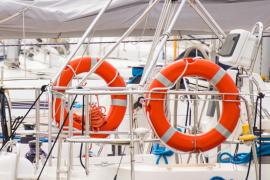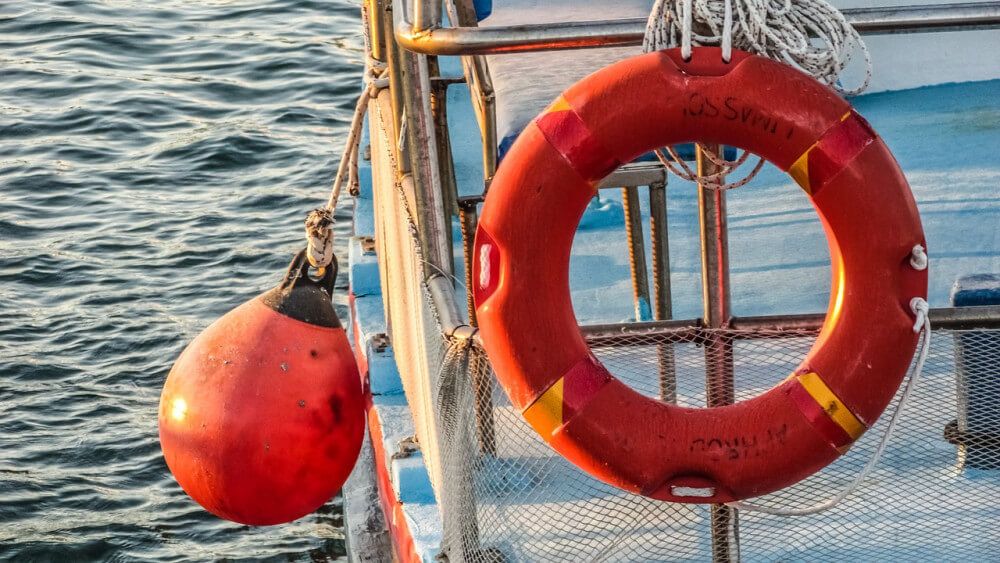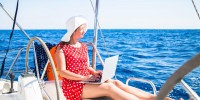Ultimate Guide to Required Safety Equipment on a Boat
The safety equipment required for your boat depends on the length of the boat, the local legislation, and the water's your sailing. Want to know precisely what you need to get to comply to the law? This article tells you what you need and how to get it.
Roughly, these are the minimum requirements:
Most sailboats in the U.S. need to carry a PFD (personal flotation devices) for each person, visual distress signals, a bell and/or whistle, and a fire extinguisher. In addition, each closed fuel or engine compartment needs to have at least two ventilation ducts.
Longer boats require more equipment, smaller boats require less. I use the U.S. Coast Guard (USCG) requirements as my baseline. If you're looking for requirements of other countries, I've added some information at the bottom.
You should be done for about $150 - $250 for most boats, depending on your specific needs. You can go way more crazy, but you definitely don't have to spend a dollar more to adhere to the minimum requirements.
I hope this article is as helpful as it is boring (list after list). In fact, to get you through it, I promise you a sailing blooper video at the end. For educational purposes let's say.
You can download a printable checklist here to make sure you have everything required by US federal law. Or you can check the interactive list below:

Interactive USCG Safety Gear List

On this page:
- Most sailboats need to bring at least:
- Coast Guard Requirements for Boats Under 16 Feet
- Coast Guard Requirements for Boats Over 16 Feet
- More Info on the Equipment
- Recommended Additional Equipment
- Is There a Quick Fix - USCG Safety Kit?
- Additional Requirement Per State
- Requirements in Canada and Australia
This article consists of three parts: in the first part I tell you what you need to bring on board specifically (boring lists). In the second part I tell you what this stuff actually is. In the third part I'll give you a checklist and suggest some kits to fix your safety gear at once. This way, you're clear on what you want to have on board, what it is, and how to get it.
Most sailboats need to bring at least:
- Life jackets for all passengers
- Fire extinguisher
- Visual distress signals for day and night time
- Sound producing devices
Skip to specifics for sailboat length:
- under 16' - 6 meters
- 16' and 26' - 6 and 8 meters
- 26' and 40' - 8 and 12 meters
- 40' and 65' - 12 and 20 meters
- 65' and 165' - 20 and 50 meters
Coast Guard Requirements for Boats Under 16 Feet
Sailboats under 16' - 6 meters:
- Personal Flotation Devices (PFDs) - One Type I, II, III, or V for each person. Must be Coast Guard approved, must fit the user, and must be readily accessible.
- Fire Extinguisher - One B-I, any type. Must be Coast Guard approved.
Not required for boats without on board engines (outboards or no engine) and permanent fuel tanks. Also, if you have a fixed system, you don't need a portable extinguisher. - If operating at night: visual distress signals that are visible during night-time
- 3 hand-held red flares (not older than 42 months) OR
- 1 electric distress light (LED)
- Bell, horn, or whistle
- Backfire Flame Arrestor
- Ventilation - Each closed engine or fuel compartment needs to have at least two vents
- Vessel lighting
Coast Guard Requirements for Boats Over 16 Feet
Sailboats between 16' and 26' - 6 and 8 meters:
- Personal Flotation Devices (PFDs) - One Type I, II, III, or V for each person on board. Also one Type IV throwable PFD. Must be Coast Guard approved, must fit the user, and must be readily accessible.
- Fire Extinguisher - One B-I, any type. Must be Coast Guard approved.
Not required for boats without on board engines (outboards or no engine) and permanent fuel tanks. Also, if you have a fixed system, you don't need a portable extinguisher. - Visual distress signals that are visible during day and night time:
3 hand-held red flares (not older than 42 months) OR
1 hand-held red flare + 2 parachute flares OR
1 hand-held orange smoke signal + 2 floating orange smoke signals + 1 electric distress light - Bell, horn, or whistle recommend
- Backfire Flame Arrestor
- Ventilation - Each closed engine or fuel compartment needs to have at least two vents
- Vessel lighting
Sailboats between 26' and 40' - 8 and 12 meters:
- Personal Flotation Devices (PFDs) - One Type I, II, III, or V for each person on board. Also one Type IV throwable PFD. Must be Coast Guard approved, must fit the user, and must be readily accessible.
- Fire Extinguisher - One B-II or two B-I, any type. Must be Coast Guard approved.
If you have a fixed system, you only need one B-I - Visual distress signals that are visible during day and night time:
3 hand-held red flares (not older than 42 months) OR
1 hand-held red flare + 2 parachute flares OR
1 hand-held orange smoke signal + 2 floating orange smoke signals + 1 electric distress light - Bell, horn, or whistle recommend
- Backfire Flame Arrestor
- Ventilation - Each closed engine or fuel compartment needs to have at least two vents
- Vessel lighting
Sailboats between 40' and 65' - 12 and 20 meters:
- Personal Flotation Devices (PFDs) - One Type I, II, III, or V for each person on board. Also one Type IV throwable PFD. Must be Coast Guard approved, must fit the user, and must be readily accessible.
- Fire Extinguisher
1 B-II + 1 B-I or 3 B-I
Must be Coast Guard approved.
If you have a fixed system, you only need two B-I or one Class B-II - Visual distress signals that are visible during day and night time:
3 hand-held red flares OR
1 hand-held red flare + 2 parachute flares OR
1 hand-held orange smoke signal + 2 floating orange smoke signals + 1 electric distress light
(Flares shouldn't be older than 42 months) - 1 Bell + 1 Whistle or horn
- Backfire Flame Arrestor
- Ventilation - Each closed engine or fuel compartment needs to have at least two vents
- Vessel lighting
Sailboats between 65' and 165' - 20 and 50 meters:
- Personal Flotation Devices (PFDs) - One Type I, II, III, or V for each person on board. Also one Type IV throwable PFD. Must be Coast Guard approved, must fit the user, and must be readily accessible.
- Fire Extinguisher
under 50 gross tons: 1 B-II
50 - 100 gross tons: 2 B-II
Must be Coast Guard approved.
If you have a fixed system, you only need two B-I or one Class B-II - Visual distress signals that are visible during day and night time:
3 hand-held red flares or ...
1 hand-held red flare + 2 parachute flares or ...
1 hand-held orange smoke signal + 2 floating orange smoke signals + 1 electric distress light
(Flares shouldn't be older than 42 months) - 1 Bell + 1 Whistle or horn
- Backfire Flame Arrestor
- Ventilation - Each closed engine or fuel compartment needs to have at least two vents
- Vessel lighting
More Info on the Equipment
Personal Flotation Devices
To make life simpler, let's just call these 'life jackets' like any normal person would. It's really important you have these. According to the USCG, 84% of all people who drowned when gone overboard were not wearing a life jacket. That's no joke, so you should not only bring these, but I encourage you to actually wear them throughout your trip.
You must carry a life jacket for each person that's on board or that's being towed by your boat (on water skis, an inflatable tube etc.). The jackets must be the right size for your passengers - if they can't wear them they're of no use.
There are several types of life jackets. Inflatable life jackets aren't approved. They come in two flavors: wearable and throwable. There are four types of wearables, and one throwable. These are creatively named:
- Type I - Offshore Life Jackets made for rough waters, provide the most buoyancy
- Type II - Near-Shore Vests made for smooth waters where rescue is likely
- Type III - Flotation Aids vests or full-sleeved jackets for calm waters
- Type IV - Throwable devices are cushions and ring buoys for throwing at people in trouble
- Type V - Special-Use Devices are hybrid PFDs for windsurfing, kayaking, waterskiing
Fire Extinguisher
There are three classes of fire extinguishers: A, B, and C. Each class represents a fire source:
- Class A: Combustible solids (wood)
- Class B: Flammable liquids (gasoline)
- Class C: Electrical fires (circuitry)
On boats, class B extinguishers are most common, as gasoline fires are your main concern. After the class letter there's a number. For example: B-I or B-II. The number just indicates the capacity of the extinguisher:
| Classification | Foam (gal.) | CO2 (lb.) | Dry Chemical (lb.) |
|---|---|---|---|
| B-I | 1.25 | 4 | 5 |
| B-II | 2.5 | 15 | 10 |
For larger boats, you need larger extinguishers.
- Small boats (up to 26' or 8 m) only need 1 B-I fire extinguisher
- Long boats (over 26' or 8 m) need 1 B-II (high capacity) extinguisher and additional B-Is, depending on the length of the boat
Visual Distress Signals
Visual Distress Signals is a fancy word for stuff that makes sure people see you when you're in trouble. You may use pyrotechnic and non-pyrotechnic signaling.
- Boats over 16 feet need to have 3 day time signals and 3 night time signals on board.
- Small boats (under 16 feet) only need to bring visual distress signals if they are sailing at night. They don't need to carry daytime visuals.
You can choose whatever combination of signals you like, as long as it adds up to 3 day and 3 night time signals. Your options are:
- Hand-held red flares (day and night)
- Parachute flares (day and night)
- LED electric distress light (night)
- Orange smoke flares (day)
- Orange distress flag (day)
- Sea-marker dye (day) - useful in case of aerial search
- Signal mirror (day) - not USCG approved, so it doesn't count, but very reliable and good to have
Flares expire. Any flares on board shouldn't be older than 42 months. After that, there's no guarantee they will work properly.
Sound Producing Devices
Bells and whistles (or horn) to signal intention or position.
Backfire Flame Arrestor
Your engine can backfire. If it does, gasoline vapor can ignite. We don't want that. That's why a backfire flame arrestor is installed on all boats with an on-board gasoline engine. This makes sure your engine doesn't fire up (pun intended).
Recommended Additional Equipment
Although not required, I encourage you to bring the following equipment, even if just sailing inland. Some of this gear is even compulsory in Australia and Canada, so it's actually important stuff.
- First Aid Kit
- Spare clothing in a waterproof bag
- Thermal blanket
- Oar/Paddle
- Tool Kit
- Compass (please bring one, it's great)
- Bilge Pump/Bailer
- Marine Radio
- Boat Hook
- Spare Parts
- Depth sounder
- Heaving line 50-70'
- Working anchor
If you sail in coastal or offshore waters, I definitely recommend to bring the following:
- Lifesling
- Safety harness (one per crew)
- Life raft
- Emergency communications
- Additonal fire extinguisher per cabin
- Extra fuel tank
- VHF radio + satellite phone
- GPS + radar
- Working anchor + storm anchor(s)
Is There a Quick Fix - USCG Safety Kit?
So, there's quite a lot to keep in mind. Surely there's some sort of starter kit right?
I have bad news for you.
There aren't any complete USCG safety kits that cover all your safety requirements. There are some simple kits with an electrical distress light, a medical kit and a whistle. But that leaves us with a lot other stuff to arrange. (They're also overpriced like mad.)
I'm not planning on shipping out my own kits any time soon. That's why I instead researched the best value option you can order on Amazon for each individual item, and list them here. It's the best I can do right now. All you have to do is sweep up the items in your cart and check out. I hope it helps.
The entire kit should cost you about $125 - $180, depending on your needs. The most expensive item being the electric distress light. All of the items below are USCG approved.
- Onyx Life Jacket Type 2 (link to check current price on Amazon) - This vest is simple and inexpensive. USCG approved, lots of positive reviews and Amazons choice.
- If your boat is over 16 feet, you should consider this very simple and inexpensive Type IV throwable PFD (click to check current price on Amazon).
- B-I Fire Extinguisher from First Alert (link to check current price on Amazon) - Best seller on Amazon. UCSG approved for marine use, simple, and inexpensive, I really like this one for my first kit.
- I prefer a LED visual distress signal over flares, as it doesn't expire. I found this USCG approved one (link to check current price on Amazon). This one is Amazons choice. It lasts you up to 60 hours (so you could even use it as a reading light if you'd ever get bored), and its visible up to 10 nautical miles (impressive). It also has the orange distress flag, so you really get two signals for the price of one.
- A whistle can be inexpensive and USCG approved as well. This very cheap one is Amazon's choice (link to check current price on Amazon).
Additional Requirement Per State
All the requirements so far apply to each U.S. state. Most states use the exact same list and don't deviate from USCG requirements. In some cases small additional demands apply. I recommend checking your state's boating law yourself.
A great resource for general state boating laws is the USCG. Check out their database here.
Find your states' safety requirements in the list of resources below. It's not extensive, but I've tried to include as much of the boating states as I could find.
- Alabama
- California
- Florida
- Texas
- Ohio
- Illinois
- Indiana
- Kentucky
- Michigan
- Massachusetts
- Maryland
- Missouri
- New York
- Louisiana
- Tennessee
Alabama
- Ignition safety switch: Alabama law requires that vessels under 24 feet (8 meters) long that have an open cockpit and more than 50hp are equipped with an ignition safety switch.
California
- Additional flags: If towing a person, you're required to have a ski flag. If you're working with divers, you must carry a divers flag.
Massachusetts
- Kids under 12 and water skiers must wear life preservers.
- Motorboats towing skiers must have a boarding ladder.
- Vessels less than 16 feet long must carry a paddle or oar.
New York
- Every vessel with an engine (except PWCs) must carry an anchor and line that's heavy and strong enough to anchor safely. The anchor line should be 7 - 10 the depth of your regular sailing waters.
- Vessels under 150 feet must carry a white light when at anchor. The light should be no higher than 20 feet above the hull.
- Sailboats under 26' and without an engine are not required to carry daytime visual distress signals.
Texas
- All vessels require at least one bright lantern when not docked.
Requirements in Canada and Australia
Requirements in Canada
Canada's requirements largely match the USCG. However, there are some additional items you need to have on board:
- Buoyant heaving line (15 m)
- Paddle or anchor with 15 m of line
- Bailer or hand pump
- Waterproof flashlight (or 3 flares)
Click here to go to Transport Canada's page on Marine Safety.
Requirements in Australia
South Australia requires you to carry the following additional equipment:
- bucket with line attached
- fire bucket
- anchor and cable
- waterproof and buoyant torch
In protected waters, you don't require to carry any flares. If in unprotected waters, you need a Radio Distress Beacon and V Sheet as well. You're also required to carry at least four liters of fresh water, a marine radio, and an approved compass.
More information for each state:
And now, as promised:
Did you find the answer to your specific question?
👍 0 👎 0


Leave a comment